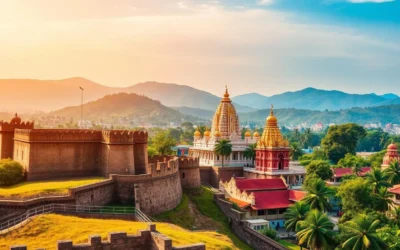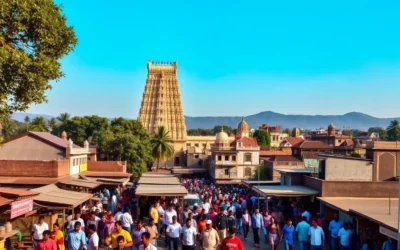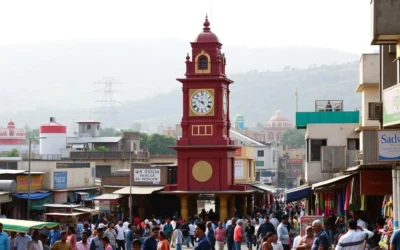✓ Accommodations✓ Flights✓ Rental Cars
Did you know that Tiruchirappalli, often referred to as Trichy, is home to some of the most magnificent temples in South India? This ancient city is a treasure trove of history, culture, and natural beauty, making it a must-visit destination for travelers.
As you explore Tiruchirappalli, you’ll discover a perfect blend of cultural heritage and natural wonders. From the iconic Rock Fort to magnificent temples, this vibrant city has something to offer for everyone. Get ready to uncover the top attractions that make Tiruchirappalli special and understand why it’s considered the cultural heart of the region.
Discovering the Cultural Heart of Tamil Nadu
As you step into Tiruchirappalli, you’re not just entering a city; you’re stepping into the heart of Tamil Nadu’s rich cultural heritage. This city, with its strategic location on the banks of the Kaveri River, has been the cradle of various cultural and historical developments. The Kaveri River, which flows through the city, has played a pivotal role in shaping its history and culture.
![]()
The Historical Significance of Tiruchirappalli
Tiruchirappalli’s historical significance is deeply intertwined with its geographical location. The city’s position in central Tamil Nadu made it a crucial point for various dynasties and empires throughout history. The influence of these dynasties can still be seen in the city’s architecture, temples, and cultural practices.
The city’s history is also marked by its role as a major agricultural hub, thanks to the fertile lands surrounding the Kaveri River. This agricultural prosperity has contributed significantly to the region’s cultural heritage, with many festivals and traditions centered around the harvest season.
| Historical Period | Ruling Dynasty | Cultural Impact |
|---|---|---|
| Early Medieval | Chola Dynasty | Development of temple architecture and cultural festivals |
| Late Medieval | Nayaka Dynasty | Influence on local art, literature, and music |
| Colonial | British Empire | Introduction of modern infrastructure and education |
Geography and Climate of the Region
Tiruchirappalli’s geography is characterized by its flat terrain, with the Kaveri River flowing through it, making the region fertile and suitable for agriculture. The city is also known for its unique geographical features, such as the massive rock formation that gives the Rock Fort its name and the island of Srirangam.
The climate of Tiruchirappalli is tropical, with hot summers from March to May, pleasant winters from November to February, and monsoon seasons that significantly influence the best times to visit. Understanding the climate is crucial for planning a visit, as the weather can greatly impact the travel experience.
- The city’s tropical climate means that the best time to visit is during the winter months when the weather is pleasant.
- The monsoon season brings much-needed rain to the region, supporting the agricultural activities.
- The flat terrain surrounding Tiruchirappalli has facilitated its growth as an important transportation hub in Tamil Nadu.
Planning Your Visit to Tiruchirappalli
Before you embark on your journey to this fascinating place, it’s crucial to know the best time to visit and how to get around. Tiruchirappalli, with its rich history and cultural significance, is a city that offers a unique blend of traditional and modern attractions.
Best Time to Visit Tiruchirappalli
The best time to visit Tiruchirappalli is from October to February when the weather is pleasant, making it ideal for sightseeing. During this period, the temperature is relatively cooler, ranging from 20 to 25 degrees Celsius, allowing you to explore the city’s numerous historical sites without the discomfort of extreme heat.
Summer months, from March to May, are characterized by high temperatures, often reaching above 35 degrees Celsius, which can be challenging for outdoor activities. The monsoon season, from June to September, brings relief from the heat but might not be the best time for visiting temples and outdoor attractions due to potential rain.

How to Reach Tiruchirappalli
Tiruchirappalli is well-connected by air, rail, and road, making it easily accessible from various parts of the country. The Trichy city airport receives flights from major Indian cities, providing a convenient entry point for travelers.
By train, Tiruchirappalli is connected to all major cities in India through the railway network. The city’s railway station is a significant hub, with numerous trains arriving and departing daily.
- For those preferring road travel, Tiruchirappalli is accessible via National Highway 38 and 336, connecting it to nearby cities and towns.
- State transport and private bus services operate regularly, offering an affordable and relatively comfortable mode of transport.
- Traveling by car or hiring a taxi is another option, providing flexibility and comfort, especially for longer distances.
Getting Around the City
Once you arrive in Tiruchirappalli, getting around the city is relatively straightforward, thanks to the various transportation options available. You can use the local bus network operated by Tamil Nadu State Transport Corporation (TNSTC) to reach major attractions.
For shorter distances, hiring an auto-rickshaw is a convenient option. It’s advisable to negotiate the fare before you start your journey to avoid any confusion.
For a more comfortable and flexible sightseeing experience, especially if you’re planning to visit multiple places in one day, consider renting a car with a driver.
Navigating the city efficiently requires some knowledge of the best routes and peak traffic hours. Planning your day accordingly can help you avoid congestion and make the most of your visit to this historic place.
The Magnificent Rock Fort Temple Complex

Perched atop a massive rock, the Rock Fort Temple Complex is an iconic landmark that offers a glimpse into the city’s storied past. As you explore this ancient site, you’ll be struck by its historical significance and architectural grandeur.
History and Architecture of the Rock Fort
The Rock Fort Temple Complex has a rich history dating back to the 8th century. It is a testament to the architectural prowess of the ancient civilizations that once flourished in this region. The complex comprises three sanctuaries, with two dedicated to Lord Ganesha, highlighting the importance of this deity in the local culture.
As you delve deeper into the history of the Rock Fort, you’ll discover the intricate carvings, sculptures, and inscriptions that adorn the walls and pillars. The temple architecture is a blend of various styles, reflecting the influences of different dynasties that ruled over Tiruchirappalli.
Climbing the 437 Steps to the Top
One of the most exhilarating experiences at the Rock Fort Temple Complex is climbing the 437 steps to the top. As you ascend, you’ll be surrounded by the serene atmosphere and the sound of chanting devotees. The climb is moderately challenging, but the panoramic views from the top make it well worth the effort.
Upon reaching the summit, you’ll find the Ucchi Pillayar Temple, a revered temple dedicated to Lord Ganesha. The temple is ingeniously built at the highest point of the rock, offering a sense of tranquility and spiritual solace.
Panoramic Views from Ucchi Pillayar Temple
From the Ucchi Pillayar Temple, you’ll be treated to breathtaking panoramic views of Tiruchirappalli city and the Kaveri River. The vistas are particularly stunning during sunrise and sunset, when the sky is painted with hues of gold and crimson.
As you take in the views, you’ll appreciate the strategic location of the temple and its significance in the region’s cultural landscape. The panoramic views of the city below offer a unique perspective on the layout and landmarks of Tiruchirappalli.
The Rock Fort Temple Complex is a must-visit destination for anyone interested in history, architecture, or spirituality. As you explore the complex, you’ll gain a deeper understanding of the region’s cultural heritage and the significance of the rock and the temple that crowns it.
Sri Ranganathaswamy Temple: A Spiritual Marvel

As you step into the Sri Ranganathaswamy Temple, you’re immediately immersed in a world of spiritual grandeur and architectural marvels. This temple, situated on the island of Srirangam, is one of the most revered sites in Hinduism and a must-visit place for anyone traveling to Tiruchirappalli.
The Sri Ranganathaswamy Temple is not just any temple; it’s a sprawling complex that showcases the rich cultural and religious heritage of the region. As you explore the temple’s vast premises, you’ll be struck by the intricate carvings, the vibrant colors, and the sense of devotion that permeates the air.
The World’s Largest Functioning Hindu Temple
The Sri Ranganathaswamy Temple holds the distinction of being the world’s largest functioning Hindu temple, covering an area of over 156 acres. This massive complex is home to numerous shrines, halls, and gopurams, making it a fascinating place to explore.
One of the most impressive aspects of the temple is its ability to accommodate a large number of devotees. The temple’s infrastructure is designed to handle the crowds, ensuring a smooth experience for visitors. However, it’s essential to plan your visit at the right time to avoid the crowds and make the most of your darshan.
The 21 Magnificent Gopurams
The Sri Ranganathaswamy Temple is renowned for its 21 magnificent gopurams, which are a sight to behold. These towering structures are adorned with intricate carvings and colorful sculptures, creating a visual spectacle that will leave you in awe. As you gaze upon the gopurams, you’ll appreciate the skill and craftsmanship that went into building this temple.
For a nominal fee of Rs.50, you can climb up to the rooftop of one of the buildings and enjoy a panoramic view of the entire complex. This vantage point offers a unique perspective on the temple’s layout and is a great way to appreciate its grandeur.
Visitor Tips and Darshan Information
To make the most of your visit to the Sri Ranganathaswamy Temple, it’s crucial to be prepared. The temple opens at 6:00 AM and remains open until 9:00 PM, giving you ample time to explore the complex. However, it’s advisable to avoid visiting during peak hours or special occasions when the crowds can be overwhelming.
For a smoother darshan experience, consider purchasing a special darshan ticket for Rs.100. This can significantly reduce your waiting time. Additionally, be sure to dress modestly and follow the temple’s etiquette guidelines, which include removing your footwear and maintaining silence in sacred areas.
As you plan your visit, remember that the temple can sometimes get extremely crowded, especially during festivals. Being prepared for the crowds and having a basic understanding of the temple’s layout can enhance your overall experience and make it a memorable one.
The Sri Ranganathaswamy Temple is truly a place of spiritual significance, and a visit here is sure to be a highlight of your trip to Tiruchirappalli. With its stunning architecture, rich history, and vibrant atmosphere, this temple is a must-visit destination that will leave a lasting impression. The experience will be a showcase of the rich cultural heritage of the region.
Exploring Srirangam Island

Nestled between the Kaveri River and its tributary, Kollidam, lies Srirangam Island, a haven of spiritual significance and cultural heritage. This river island, situated within the city of Tiruchirappalli in Tamil Nadu, India, is a treasure trove of history, architecture, and faith.
The Sacred Island Between Two Rivers
Srirangam Island is formed by the Kaveri River and its tributary, Kollidam, creating a serene and sacred place. The island stretches 19 miles in length and 1.5 miles in width, offering a tranquil escape from the bustling city life. As a significant site in Vaishnavism, it houses not only the revered Sri Ranganathaswamy Temple but also numerous other shrines and religious institutions, making it a temple town of great importance.
The island’s unique geography, with the rivers surrounding it, is steeped in Hindu mythology. According to legend, Srirangam is believed to be a piece of Adisesha (the cosmic serpent) that fell to earth from heaven, adding to its religious significance. This mythological background has made Srirangam a crucial place for pilgrims and devotees of Lord Vishnu.
Cultural Significance and Religious Importance
Srirangam Island is not just a temple town; it’s a hub of cultural activities and learning. For centuries, it has been a center for Tamil literature, music, dance, and religious discourse, enriching the cultural fabric of the region. The traditional Brahmin agraharams (residential quarters) on the island showcase a unique architectural style and lifestyle, characteristic of a place deeply rooted in tradition.
The island has preserved ancient religious practices and rituals that have remained largely unchanged for over a thousand years, making it a living museum of Hindu traditions. Visitors to Srirangam Island can experience the rich cultural heritage and religious practices firsthand by visiting the various temples and participating in the daily rituals and ceremonies.
As you explore Srirangam Island, you’ll discover why it’s considered one of the most sacred sites in Vaishnavism. With its serene environment, rich history, and vibrant cultural scene, Srirangam Island is a must-visit place for anyone interested in exploring the spiritual heart of Tamil Nadu.
Jambukeswarar Temple: The Water Lingam

Nestled in the heart of Srirangam island, the Jambukeswarar Temple is a sacred place where the divine and the natural world converge. As you visit this ancient Shiva sanctuary, you’ll be drawn into a world of mystique and spirituality.
Ancient Architecture and Religious Significance
The Jambukeswarar Temple, built by Kocengannan, one of the Early Cholas, around 1,800 years ago, is a masterpiece of ancient Dravidian architecture. The temple’s design and layout reflect the rich cultural and religious heritage of the region. As you explore the temple complex, you’ll notice the intricate carvings and sculptures that adorn the walls and pillars, telling stories of mythological significance.
The temple is one of the Pancha Bhoota Sthalams, representing Lord Shiva’s manifestation as the water element. This classification underscores the temple’s importance in Hindu philosophy and its connection to the natural world.
The Unique Water Lingam and Its Mythology
At the heart of the Jambukeswarar Temple lies the unique water Lingam, a rare and mystical phenomenon where water continuously springs from the ground around the Shiva Lingam. According to mythology, Goddess Parvati, worshipped here as Akilandeswari, performed penance under a jambu tree and created a lingam of water to worship Lord Shiva. This mythological event is central to the temple’s identity and spiritual significance.
The ever-flowing water symbolizes the eternal nature of divine consciousness in Hindu philosophy. As you witness this natural wonder, you’ll appreciate the symbolic meaning behind the continuous flow of water, representing the infinite and the divine.
The sacred tank, Amrita Pushkarini, within the temple complex, plays a significant role in temple rituals and mythology. You can explore this tank and understand its importance in the spiritual practices of the temple.
Butterfly Park: A Colorful Natural Haven

As one of Asia’s largest butterfly parks, Tiruchirappalli’s Butterfly Park is a spectacle of color and life. Spread over 35 acres, this park has been developed at a cost of approximately ₹8 crores and is a haven for nature lovers and butterfly enthusiasts alike.
The park is home to over 100 different species of butterflies, displaying a stunning array of colors, patterns, and sizes. As you walk through the park, you’ll discover the incredible diversity of butterfly species and learn about the carefully selected host plants and nectar plants that have been cultivated to support the butterfly population throughout their life cycle.
Asia’s Largest Butterfly Park
The Butterfly Park in Tiruchirappalli is considered one of the biggest butterfly parks in Asia. It boasts a beautiful garden, a fountain, and the largest butterfly glass house, creating a unique and fascinating environment for visitors.
The park’s design includes beautifully landscaped gardens, walking paths, and water features that create different microhabitats within the park. These features not only support the butterfly population but also provide a habitat for birds, small mammals, and beneficial insects that contribute to the ecological balance.
As you explore the park, you’ll understand how the ecosystem supports a wide range of flora and fauna, making it a truly unique destination.
Flora and Fauna of the Park
The Butterfly Park is not just about butterflies; it’s a thriving ecosystem that supports a variety of plant and animal life. The gardens within the park are carefully maintained to provide a welcoming environment for butterflies and other species.
The park’s flora includes a variety of host plants and nectar plants that are essential for the survival of the butterfly population. As you visit the park, you’ll have the opportunity to learn about the different species of butterflies and the plants that support them.
Understanding the seasonal variations in butterfly populations can help you plan your visit to witness specific species and maximum butterfly activity. The park’s ecosystem is designed to support the butterflies throughout their life cycle, ensuring a vibrant display of colors and life throughout the year.
By visiting the Butterfly Park in Tiruchirappalli, you’re not only experiencing the beauty of nature but also contributing to the conservation of this delicate ecosystem.
Kallanai Dam: The Ancient Engineering Marvel

As you approach the Kallanai Dam, you’re stepping into a piece of history that spans over 2000 years. Located about 15 kilometers from Tiruchirappalli city on the banks of the Cauvery River, this ancient dam is a must-visit destination for anyone interested in history, engineering, or natural beauty.
The 2000-Year-Old Functional Dam
The Kallanai Dam is an engineering marvel that has stood the test of time. Initially built around 2000 years ago, it remains the oldest functional dam in the world. Spanning over 1079 feet and more than 66 feet wide, this dam has been a crucial part of the region’s irrigation system for centuries.
The dam’s construction is a testament to the advanced engineering skills of the ancient civilization that built it. Despite being over two millennia old, the dam still serves its purpose, showcasing the ingenuity of its creators.
Visiting the Grand Anicut
Visiting the Kallanai Dam, also known as the Grand Anicut, is a unique experience. The best time to visit is during the monsoon season when the water flow is at its peak, offering a breathtaking sight. The surrounding area provides beautiful riverside views and ample opportunities for photography, especially during sunrise and sunset.
As you explore this historical place, you’ll notice the modern additions to the ancient structure, including the regulation mechanisms added by the British in 1839-1840, which enhanced its functionality. The peaceful atmosphere of this historical site, combining engineering heritage with natural beauty, makes it a perfect half-day excursion from Tiruchirappalli.
The Kallanai Dam is not just a historical monument but a living example of ancient engineering that continues to benefit the region. As you stand on its banks, you can appreciate the blend of history, engineering, and nature, making it a truly enriching experience.
Samayapuram Mariamman Temple: A Center of Devotion

The Samayapuram Mariamman Temple, dedicated to the powerful goddess Mariamman, is a significant cultural and religious landmark. You can experience the rich history and vibrant festivals that make this temple a must-visit destination.
The Powerful Goddess and Her Worship
The Samayapuram Mariamman Temple is renowned for its association with the goddess Mariamman, a symbol of Shakti or divine power. You will find that the temple’s sanctum houses the idol of Mariamman, worshipped for her protective powers and benevolence. Devotees visit the temple to seek blessings and offer prayers, often participating in unique rituals associated with Mariamman worship.
These rituals include fire walking ceremonies, where devotees walk on hot coals as a demonstration of their faith, and offerings of saffron clothes, turmeric, and sugar candy to the goddess. You can observe or participate in these rituals during your visit, gaining a deeper understanding of the local culture and religious practices.
Festivals and Celebrations at the Temple
The Samayapuram Mariamman Temple is known for its vibrant festivals, particularly the annual Panguni festival, which takes place in March-April. You can experience the excitement as hundreds of thousands of devotees gather to celebrate this significant event, marking an important time in the temple’s calendar.
Another spectacular celebration is the car festival, or Ther Thiruvizha, where the goddess’s idol is taken around the temple in an elaborately decorated chariot pulled by devotees. You will be captivated by the colorful procession and the community spirit that pervades during this time. The festival is a celebration of faith, tradition, and community, making it a memorable experience for all who attend.
As you plan your visit to the Samayapuram Mariamman Temple, consider the timing of these festivals to make the most of your experience. Whether you’re there during a major celebration or a quieter time, the temple’s atmosphere is sure to leave a lasting impression.
Rani Mangammal District Museum: A Glimpse into History

Step into the Rani Mangammal District Museum to uncover the secrets and stories of Tiruchirappalli’s ancient civilizations. This museum is a treasure trove of historical artifacts and collections that provide a comprehensive insight into the region’s rich cultural heritage.
Ancient Artifacts and Historical Collections
The Rani Mangammal District Museum is home to an impressive collection of ancient artifacts that date back to various periods in history. You can marvel at the museum’s collection of bronze statues from the Chola period (9th-13th centuries), renowned for their artistic excellence and historical significance. These statues are a testament to the advanced craftsmanship of the artisans of that era.
The museum also houses a vast collection of other historical objects, including fossils, ancient mega lithic instruments, Pale lithic devices, and Neo lithic artifacts. These exhibits offer a glimpse into the lives of the people who lived in the region during different periods, showcasing their tools, art, and way of life.
Rare Statues and Archaeological Treasures
One of the highlights of the Rani Mangammal District Museum is its collection of rare statues, including those of Gautama Buddha, Mahavira, and Lord Vishnu. These statues are not only significant for their religious importance but also for their artistic and historical value. You can discover the rare stone sculptures that showcase the evolution of South Indian art styles across different dynasties, from the Pallavas to the Nayaks.
The museum is also home to a vast collection of archaeological treasures unearthed from various sites around Tiruchirappalli. These include coins, inscriptions, and everyday objects that offer insights into ancient life. Additionally, the museum preserves palm leaf manuscripts and ancient documents that are crucial for understanding Tamil literature and historical records.
As you explore the museum, you’ll appreciate the meticulous conservation efforts that go into maintaining these priceless artifacts and making them accessible to the public. The Rani Mangammal District Museum is not just a repository of historical objects; it’s a gateway to understanding the rich cultural heritage of Tiruchirappalli.
Our Lady of Lourdes Church: Gothic Grandeur

Our Lady of Lourdes Church, a majestic structure in Tiruchirappalli, is a must-visit destination for anyone interested in history, architecture, or spirituality. Located in the heart of the city, this church is a significant Catholic pilgrimage site in South India, dedicated to the Marian apparitions at Lourdes, France.
The Architectural Beauty of the Church
The Our Lady of Lourdes Church is renowned for its stunning Gallo-Catholic architecture, which includes neo-Gothic towers and intricate paintings depicting scenes of martyrdom. As you step inside, you’ll be greeted by beautiful stained glass windows that narrate biblical scenes and the life of the Virgin Mary, creating a serene and contemplative atmosphere.
The church’s interior is a masterpiece of religious art, with detailed craftsmanship that reflects the devotion and faith of the community. The architecture is not just aesthetically pleasing but also holds deep religious significance, making it a place of reverence for visitors from all over the world.
Religious Significance and Visitor Information
Our Lady of Lourdes Church is an important place of worship for the local Catholic community, and visitors are welcome to attend Mass services to experience the vibrant faith and traditions. The church is usually open from 6:00 AM to 8:00 PM daily, and visitors are advised to dress modestly, covering their shoulders and knees as a sign of respect.
Photography is allowed, but it’s recommended to be discreet and respectful of the worshippers. The peaceful grounds of the church offer a quiet retreat from the bustling city, providing a space for contemplation and reflection regardless of your religious background.
Whether you’re looking to explore the spiritual side of Tiruchirappalli or simply seeking a serene spot to relax, Our Lady of Lourdes Church is a place that promises a enriching experience. Plan your visit during the Mass services to witness the community’s devotion and enjoy the traditional hymns.
Erumbeeswarar Temple: A Chola Masterpiece

As you explore Tiruchirappalli, the Erumbeeswarar Temple emerges as a must-visit destination, embodying the essence of Chola craftsmanship. This ancient temple, dedicated to Lord Shiva, is a testament to the region’s rich cultural and spiritual heritage.
Historical Background and Architectural Features
The Erumbeeswarar Temple was built by Aditya Chola along the banks of the River Cauvery to commemorate his victory over the Pandyas in the Tirupurambiyam Battle in 885 CE. This historical context is crucial in understanding the temple’s significance. The temple features several inscriptions that provide insights into the Chola dynasty’s reign and their architectural achievements.
Architectural Features: The temple’s architecture is characterized by intricate carvings and sculptures that adorn its walls and pillars. The sanctum sanctorum houses the Lingam, a symbol of Lord Shiva, which is the central object of worship. The temple’s design reflects the traditional Dravidian style, with gopurams and vimanas that are typical of Chola architecture.
Religious Practices and Visiting Experience
Visitors to the Erumbeeswarar Temple can experience traditional worship practices, where Lord Shiva is revered in his aspect as the lord who appeared on a bull (Erumbu). The daily rituals and special ceremonies performed at the temple follow traditions that have remained largely unchanged for over a thousand years.
Best Times to Visit: For a peaceful experience, it is recommended to visit the temple during the early morning or evening aartis (ritual of lights). The serene atmosphere and less crowded conditions compared to larger temples offer a more intimate connection with Tamil religious traditions.
The Erumbeeswarar Temple is not just a place of worship; it is a journey into the past, offering a glimpse into the rich cultural and historical heritage of the region. As you plan your visit to Tiruchirappalli, make sure to include this magnificent temple in your itinerary.
Vayalur Murugan Temple: Spiritual Serenity

As you approach the Vayalur Murugan Temple, you’re enveloped in an atmosphere of tranquility and devotion. This sacred site in Tamil Nadu is dedicated to the worship of Lord Muruga, a revered deity in Hinduism.
The Worship of Lord Muruga
The Vayalur Murugan Temple is particularly significant for its worship of Lord Muruga, whose six-faced idol, known as Arumugam, represents his six primary qualities or aspects. Devotees flock to this temple to seek blessings and participate in sacred rituals.
The worship here is not limited to Lord Muruga; the temple also houses several shrines dedicated to Lord Shiva, making it a revered site among his devotees as well. The unique blend of Shaivism and Kaumaram (the worship of Lord Muruga) creates a rich tapestry of spiritual practices.
Temple Architecture and Sacred Rituals
The architecture of the Vayalur Murugan Temple is a testament to the traditional Dravidian style, characterized by its majestic gopuram (tower), mandapam (hall), and sanctum sanctorum. The intricate carvings and ornate details on the temple structures reflect the skill and craftsmanship of ancient artisans.
The temple is also known for its sacred rituals, including special abhishekams (sacred baths) for the deity and the offering of peacock feathers, which are particularly dear to Lord Muruga. These rituals are performed with great devotion, creating a deeply spiritual atmosphere that resonates with visitors.
Located in a relatively serene area, the Vayalur Murugan Temple offers a peaceful spiritual experience, distinct from the more crowded tourist destinations in Tiruchirappalli. Visitors can appreciate the architecture and participate in the rituals, making for a fulfilling visit.
Culinary Delights of Tiruchirappalli
The city of Tiruchirappalli is a food lover’s paradise, with its unique blend of traditional and contemporary cuisine. As you explore this historic city, you’ll discover a diverse range of local specialties that reflect the rich cultural heritage of Tamil Nadu.

Traditional Tamil Cuisine to Try
Tiruchirappalli is renowned for its traditional Tamil cuisine, which is characterized by the use of aromatic spices, fresh ingredients, and traditional preparation methods. Some must-try dishes include:
- Chettinad Cuisine: Known for its bold flavors and spices, Chettinad cuisine is a highlight of Tiruchirappalli’s culinary scene. Be sure to try dishes like Chettinad chicken or mutton curry.
- Idli and Dosa: These South Indian staples are a common feature in many local restaurants. Enjoy them with a variety of chutneys and sambar.
- Traditional Tamil Meals: Experience the traditional Tamil Nadu thali, which includes a variety of dishes served on a banana leaf.
When it comes to dining, you can find a range of options to suit every budget and preference. From street food stalls to high-end restaurants, Tiruchirappalli offers a culinary experience that’s hard to forget.
Best Restaurants and Food Spots
Some of the top recommendations for dining in Tiruchirappalli include:
- Sangam Hotel’s Restaurant: This is a great place to try authentic Chettinad cuisine, known for its aromatic spices and traditional preparation methods.
- Local Favorites: Restaurants like Shri Ayyappan Mess and Kannappa Hotel offer delicious Tamil meals at reasonable prices.
- Sweet Shops: Visit Sri Krishna Sweets to sample traditional South Indian desserts like Mysore Pak and Jangiri.
- Street Food: Explore the street food areas around Rock Fort and Chathiram Bus Stand to try local snacks like Bonda, Bajji, and Vadai.
- Modern Dining: For a more upscale experience, consider dining at modern restaurants that blend traditional flavors with contemporary presentation.
Whether you’re in the mood for traditional Tamil cuisine or modern fusion dishes, Tiruchirappalli has something to offer every kind of food enthusiast. Be sure to explore the local culinary scene during your visit to this vibrant city.
Accommodation Options in Tiruchirappalli
Tiruchirappalli offers a diverse range of accommodation options to suit every traveler’s needs and budget. Whether you’re looking for a luxurious stay or a budget-friendly place to rest, the city has something for everyone.

Luxury and Mid-Range Hotels
For travelers seeking comfort and luxury, Tiruchirappalli has a variety of high-end hotels that offer top-notch amenities and services. These hotels are equipped with modern facilities, including spas, fitness centers, and fine dining restaurants, ensuring a pleasant stay. Some of the prominent luxury hotels in the city include those with elegant decor, spacious rooms, and exceptional hospitality.
Mid-range hotels in Tiruchirappalli provide a balance between quality and affordability. They offer clean, comfortable rooms and basic amenities like free Wi-Fi, room service, and on-site dining. These hotels are ideal for travelers who want a comfortable stay without breaking the bank.
Key Features of Luxury and Mid-Range Hotels:
- Luxurious amenities and modern facilities
- Exceptional service and hospitality
- Variety of dining options
- Comfortable and well-appointed rooms
Budget-Friendly Stays and Guesthouses
For budget-conscious travelers, Tiruchirappalli offers a range of affordable accommodation options, including budget hotels, guesthouses, and homestays. Places like Hotel Rockfort, Hotel Sri Sai Ram, and Hotel Gnanam are popular among travelers for their clean rooms and basic amenities at affordable rates.
Government-run Tamil Nadu Tourism Development Corporation (TTDC) hotels are another reliable option for budget travelers. These hotels offer regulated prices and reliable service, making them a great choice for those looking for a hassle-free stay.
Guesthouses and homestays provide an authentic local experience, allowing travelers to immerse themselves in the local culture. Many of these establishments offer home-cooked meals, giving visitors a taste of traditional Tamil cuisine.
Tips for Choosing Budget-Friendly Accommodations:
- Consider the location and proximity to major attractions and transportation hubs
- Look for places that offer basic amenities and clean rooms
- Check for seasonal pricing variations and book in advance to get the best deals
- Read reviews and ask for recommendations to ensure a pleasant stay
By considering these options and tips, you can find the perfect place to stay in Tiruchirappalli that fits your budget and meets your needs.
Conclusion: Making the Most of Your Tiruchirappalli Adventure
Your visit to Tiruchirappalli will be a perfect blend of spiritual enrichment, historical discovery, and cultural immersion. As you conclude your journey through this ancient city, you’ll find that it has something for everyone, whether you’re a history buff, a spiritual seeker, or simply a traveler looking to experience the authentic charm of Tamil Nadu.
To make the most of your trip, consider planning your itinerary according to your interests and the duration of your stay. For a quick visit, a 2-day itinerary can give you a glimpse into the city’s rich heritage, covering major attractions like the Rock Fort Temple and Sri Ranganathaswamy Temple. If you have 3-4 days, you can explore the surrounding areas, including the Jambukeswarar Temple and Kallanai Dam, providing a more comprehensive experience.
For those who have a week or more, an immersive journey through Tiruchirappalli and its neighboring cities like Thanjavur, Madurai, or Kumbakonam can offer a deeper understanding of the region’s history and culture. This allows you to visit multiple temples, experience local festivals, and enjoy the unique cuisine of the region.
When visiting temples, it’s essential to be mindful of the local customs and traditions. Dress modestly, remove your shoes when required, and follow the guidelines provided by the temple authorities. This not only shows respect but also enhances your overall experience.
As you prepare to leave, don’t forget to take back some memories in the form of souvenirs. Tiruchirappalli offers a range of traditional handicrafts, textiles, and local specialties that make for great keepsakes. Whether it’s a bronze statue, a piece of handloom fabric, or some local delicacies, these items will remind you of the city’s vibrant culture.
In conclusion, Tiruchirappalli is a destination that offers a unique blend of history, spirituality, and culture. With careful planning and an open mind, your visit to this city can be a truly enriching experience. Whether you’re spending a few days or a week in Tiruchirappalli, you’re sure to leave with a deeper appreciation for this incredible place and the memories that will last a time to cherish.
—
The above is subject to change.
Check back often to TRAVEL.COM for the latest travel tips and deals.






